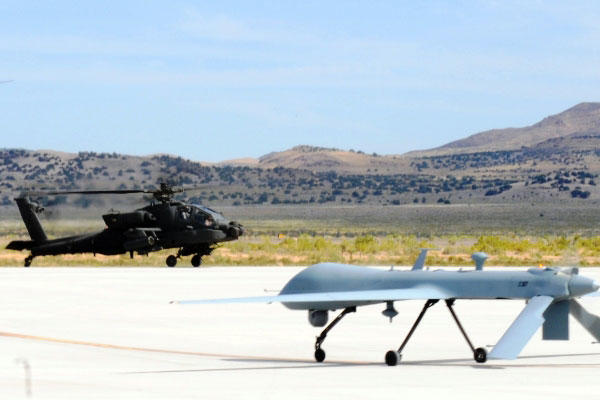The U.S. Army has started equipping aviation brigades with drones as it retires aging reconnaissance helicopters and pushes to further integrate unmanned technology amid budget cuts.
Combat aviation brigades at Fort Bliss, Texas, and Fort Carson, Colorado, are expected to finish divesting OH-58 Kiowa Warrior scout helicopters and adding RQ-7 Shadow unmanned aerial systems later this year, according to Col. Thomas von Eschenbach. A total of 10 or so brigades are slated to make the transition over the next three to four years, he said.
The move is part of the Army's novel but controversial plan to cut costs while retaining newer technology by overhauling aviation units. The so-called Aviation Restructuring Initiative calls for retiring the Kiowas and TH-67 trainers, transferring the National Guard's AH-64 Apache attack helicopters to the active component, moving some UH-60 Black Hawk utility choppers from active to Guard units, and buying new UH-72 Lakota light rotorcraft.
"The Army has wanted to replace the aging Kiowa for over a decade," Mark Gunzinger and Chris Dougherty, fellows at the Center for Strategic and Budgetary Assessments, a think tank in Washington, D.C., said in an e-mail. "Frankly, the Army may be on the cusp of breaking new ground in how it plans to fully integrate unmanned aircraft operations with ground units and manned systems operations."
Under a concept known as manned-unmanned teaming, the Apaches would be paired with drones, including the low-altitude Shadow and the high-altitude MQ-1 Gray Eagle, to perform both the armed reconnaissance and attack missions.
The restructuring plan "has allowed us to essentially recapitalize and reinvest UAS assets that probably would have been divested in a smaller Army, and use those and put them into aviation formations," said von Eschenbach, who assesses unmanned technology for Training and Doctrine Command at Fort Rucker, Alabama.
The U.S. military has about 500 Shadows and about 240 Predators and Gray Eagles, according to a Pentagon report from December on unmanned systems.
Over the past decade of war in Iraq and Afghanistan, infantry soldiers in brigade combat teams used drones such as the Shadow, which features an electro-optical/infrared camera, to monitor the battlefield in real-time and track insurgents planting roadside bombs. Now, the Army wants to formally incorporate the technology into reorganized combat aviation brigades.
Each aviation brigade will include an attack reconnaissance squadron consisting of three Apache troops, for a total of 24 attack helicopters, and three Shadow platoons, for a total of 12 of the drones, von Eschenbach said. Each platoon will include four of the air vehicles and two ground control stations mounted in the back of Humvees to provide round-the-clock surveillance for a mission, he said.
Combining both types of aircraft lets helicopter pilots see the battlefield and strike targets from a much greater distance by delivering video from a drone's camera directly into the cockpit, von Eschenbach said.
"It just gives you a lot more flexibility in making decisions," he said. "It allows you to spread your assets and cover a wider area."
The newest version of the Shadow also takes advantage of a universal ground control station specifically designed for missions involving both manned and unmanned aircraft, according to Bill Irby, senior vice president and general manager for Textron's unmanned systems unit.
"We expect both to be powerful force multipliers," he said in an e-mail.
Yet the Army's push to incorporate drones into its organizational structure doesn't necessarily mean they'll take the place of a new armed aerial scout helicopter. The service still has a need for such a platform, some say, though a program to develop a Kiowa successor was canceled last fall due to defense spending reductions.
"The Army will still want the AAS for a variety of missions for which Shadow UAS are ill-suited," Gunzinger and Dougherty said. "Shadows are very small, not terribly maneuverable, can't carry much in the way of weapons or sensors, and will require constant communication uplinks for command and control. So, in the long run the Shadow may be more of a complementary capability."
And while the Army won't face nearly as much of a cultural challenge as the Air Force or the Navy in convincing pilots of the benefits of unmanned technology, the service has its share of skeptics, von Eschenbach said.
"Anytime you introduce change into a system, change is not easy," he said. "Once people realize the capabilities of what it does, they're sold."
-- Brendan McGarry can be reached at Brendan.McGarry@monster.com.




























